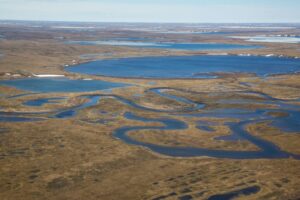
Mitigation on the Frontier
Alaska is on the forefront of a new effort to take a broader look at how to mitigate against the impacts of development. Instead of taking a piecemeal, project-by-project approach to mitigation, the Department of the Interior (Interior) is calling for the development of regional mitigation plans that look more broadly at landscapes and cumulative impacts, before projects are proposed.

The Reserve is an important area for the Western Arctic and Teshekpuk caribou herds. BLM photo by Bob Wick.
In Alaska, this effort came out of the adverse effects from oil and gas development to subsistence, habitat, and wildlife in the National Petroleum Reserve–Alaska (Reserve). The Reserve provides rich habitat for caribou, grizzly and polar bears, wolves, and a wide range of migratory birds. The Reserve also provides vital hunting and fishing grounds for subsistence users.
But oil and gas development near the community of Nuiqsut is threatening people’s subsistence way of life.
This threat is leading the Bureau of Land Management (BLM) to look for a better way to mitigate against the impacts of oil and gas development in the region.
Room for Improvement
Mitigation is not a new concept. Agencies typically follow a three-step hierarchy when adopting mitigation measures. First, agencies avoid impacts by modifying the project design or location, or by not allowing a project. Then, agencies will try to minimize impacts that couldn’t be avoided through project modifications or permit conditions. Finally, agencies should require compensation for any impacts that could not otherwise be avoided or minimized. Compensatory mitigation may involve restoration, creation, enhancement, or preservation of other areas, or potentially payment of a fee.
Several laws already require consideration or use of mitigation measures. For example, any Endangered Species Act permit that allows the taking of a protected species must set out how the applicant will “minimize and mitigate the impacts” to that species. The National Environmental Policy Act requires that agencies consider the environmental impacts from their actions and identify potential mitigation measures.

Long-tail ducks and many other species of waterfowl come to the Reserve to breed each summer. BLM photo by Bob Wick.
The U.S. Army Corps of Engineers (Corps) also requires mitigation for Clean Water Act (CWA) permits that allow discharges into wetlands, streams, and other waters. When there is a proposed discharge, the Corps must first ensure that all steps are taken to avoid or minimize the impacts. The Corps requires compensatory mitigation if there are still unavoidable impacts from the project.
Because of the number of wetlands on the North Slope, development projects often trigger compensatory mitigation requirements under the CWA. But CWA compensatory mitigation does little to address other types of impacts, such as impacts to subsistence users from development projects. Projects may also take place hundreds or thousands of miles away, which does little to address impacts in the areas most affected by development. And developers don’t always follow through with the required mitigation measures.
A New Toolbox
Interior and other agencies are working to find ways to better mitigate against the impacts of development. In 2013, Interior Secretary Sally Jewell issued Secretarial Order 3330, titled Improving Mitigation Policies and Practices of the Department of the Interior. The order calls on agencies to strengthen their policies, evaluate potential mitigation measures early on in the planning process, and ensure mitigation measures last over time.
The order also directs agencies to consider mitigation options on a regional or landscape level. Mitigation in the past has typically been developed on a case-by-case basis and in a site-specific manner. This narrowly focused, ad hoc approach does little to address the cumulative impacts of development and provides little certainty over how the agency will achieve effective mitigation over time or over broad areas.
In November 2015, President Obama issued a presidential memorandum on mitigation. The memorandum builds on and reinforces efforts related to mitigation. For example, it directs Interior and other agencies to set a goal of achieving a net benefit or, at a minimum, no net loss for the natural resources managed by the agencies. The memorandum also encourages agencies to adopt mitigation measures that achieve environmental benefits before impacts occur and that will last for at least as long as the impacts of the project and its impacts.
These are just a few of the new tools driving BLM to take a fresh look at how it approaches mitigation. It is against this backdrop that BLM is working to develop a broader plan for the Reserve.
Mitigation in the Reserve

The 22.8 million acre National Petroleum Reserve-Alaska, the first location to use the new approach, includes important nesting habitat for migratory birds. BLM photo by Bob Wick.
In early 2013, BLM finalized the first-ever comprehensive management plan for the Reserve—the Integrated Activity Plan (IAP). Under the IAP, the oil and gas industry has access to roughly 72 percent of the Reserve’s economically recoverable oil. The IAP lays out several provisions designed to offset the negative impacts of oil and gas development. This includes protective buffers around key subsistence areas, such as Fish Creek near the community of Nuiqsut. It also contains new and strengthened protections for designated Special Areas with significant habitat, wildlife, and other values.
But the very first time that BLM authorized a project after the IAP, the Greater Mooses Tooth 1 (GMT-1) project, BLM waived a key protective provision that would have kept oil and gas infrastructure out of the buffer around Fish Creek. BLM also recognized there would be significant impacts to subsistence users from their decision to allow the project to go forward.
To address some of those impacts, BLM required additional mitigation funding of $8 million from ConocoPhillips. BLM also indicated it would develop a mitigation plan—called a Regional Mitigation Strategy (RMS)—for the northeast area of the Reserve.
The RMS is intended to serve as a blueprint for how BLM will mitigate against the adverse effects from future development projects in the Reserve. The goal with the RMS is to take a broader look at how to achieve meaningful mitigation on a regional basis, before industry moves forward with additional development projects.
This is a new process. And BLM and the Reserve are one of the first nationwide to do it. BLM is in the process of developing regional mitigation plans in the lower 48, primarily in the context of large-scale renewable energy projects. But the RMS for the Reserve is unique because it is intended to address subsistence, sociocultural, and other impacts to residents of the region.
BLM is expected to finalize the RMS for the Reserve later this fall. Trustees for Alaska and our partners are working to ensure that the RMS sets out meaningful measures that will mitigate against the harm to subsistence, wildlife, habitat, and other values from existing and future development in the Reserve and achieve conservation of some of the Reserve’s most valuable areas.


